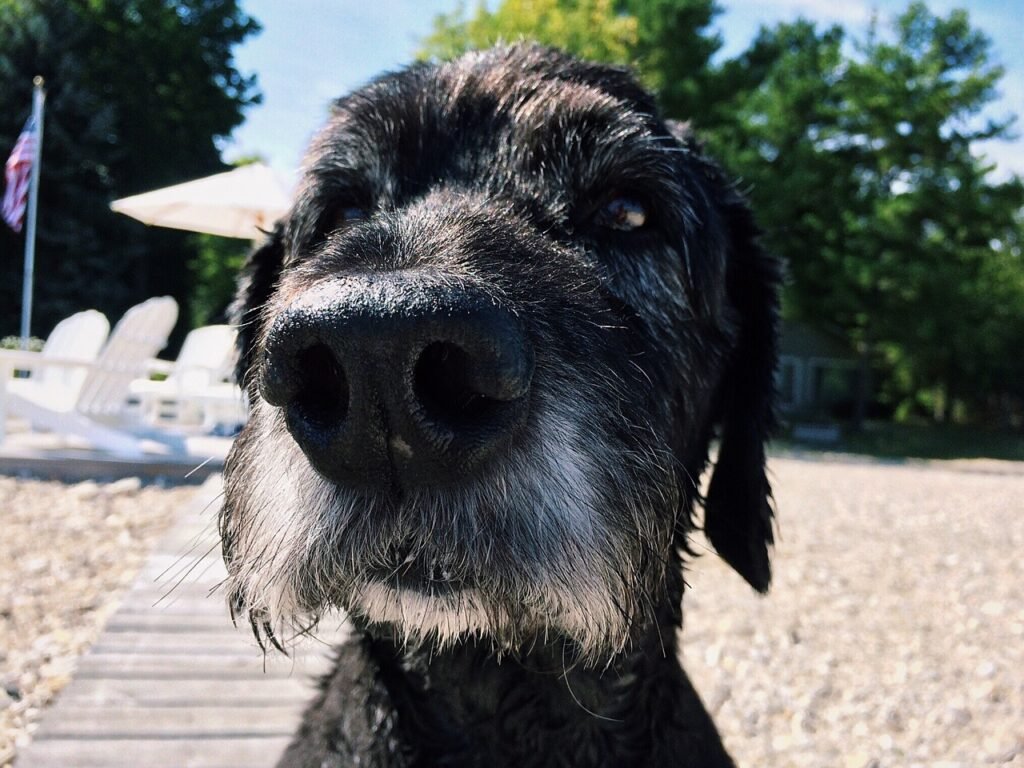
Coping with Stress and Anxiety in Aging Dogs
As our furry companions age, they, like us, can experience stress and anxiety. Watching our beloved dogs navigate the challenges of aging can be heart-wrenching, but there are methods to help them cope and improve their quality of life. From decreased mobility to cognitive decline, aging dogs can exhibit signs of stress and anxiety in various ways. In this article, we’ll explore effective strategies to support and comfort aging dogs as they navigate this life stage. We’ll delve into how to recognize signs of stress and anxiety, the impact of aging on their mental well-being, and proven techniques to provide comfort and relief. Whether it’s creating a peaceful environment, incorporating gentle exercises, or exploring natural remedies, there’s a range of options to alleviate their stress. By understanding and addressing our aging dogs’ emotional needs, we can create a supportive and loving environment for them to thrive in their golden years.
Understanding Stress and Anxiety in Aging Dogs
Aging dogs, much like humans, experience changes in their physical and mental health as they grow older. These changes can lead to stress and anxiety, affecting their overall well-being. It’s crucial for dog owners to understand the signs of stress and anxiety in their aging pets, as well as the underlying causes. By recognizing these indicators, pet owners can take proactive steps to alleviate their dogs’ distress and improve their quality of life.
Stress and anxiety in aging dogs can manifest in various ways, including changes in behavior, appetite, and sleep patterns. Some dogs may become more withdrawn and exhibit signs of fear or agitation, while others may display destructive behaviors or excessive vocalization. Understanding these behavioral changes is the first step in addressing the emotional needs of aging dogs. Additionally, physical symptoms such as restlessness, panting, and trembling can also indicate heightened stress levels. By paying close attention to these signs, pet owners can provide targeted support to help their aging dogs cope with stress and anxiety.
Moreover, the impact of stress and anxiety on aging dogs’ overall health should not be underestimated. Chronic stress can weaken the immune system, exacerbate existing health issues, and contribute to a decline in cognitive function. It’s essential for pet owners to prioritize their aging dogs’ mental well-being alongside their physical care. With a comprehensive understanding of stress and anxiety in aging dogs, pet owners can implement effective strategies to mitigate these challenges and enhance their pets’ golden years.
Signs and Symptoms of Stress and Anxiety in Aging Dogs

Recognizing the signs and symptoms of stress and anxiety in aging dogs is crucial for providing timely intervention and support. While some symptoms may be subtle, others can be more overt and easily identifiable. By familiarizing themselves with these indicators, pet owners can gain insight into their aging dogs’ emotional state and take appropriate action to alleviate their distress.
Common signs of stress and anxiety in aging dogs include changes in appetite, such as decreased or increased food intake. Some dogs may also exhibit changes in their elimination habits, including accidents indoors or increased frequency of urination. Additionally, alterations in sleeping patterns, such as restlessness or excessive sleep, can signal heightened stress levels. Behavioral changes, such as increased irritability, excessive grooming, or withdrawal from social interaction, are also indicative of emotional distress in aging dogs.
Physical symptoms of stress and anxiety, such as panting, trembling, and dilated pupils, should not be overlooked. These manifestations of stress can significantly impact an aging dog’s overall well-being. By being attuned to these signs and symptoms, pet owners can take proactive measures to address their dogs’ emotional needs and provide a supportive environment that promotes relaxation and comfort.
Furthermore, it’s essential for pet owners to observe their aging dogs’ body language for subtle cues of stress and anxiety. Changes in posture, facial expressions, and vocalizations can offer valuable insights into their emotional state. By paying close attention to these non-verbal communication cues, pet owners can better understand and respond to their aging dogs’ emotional needs.
Common Causes of Stress and Anxiety in Aging Dogs
The causes of stress and anxiety in aging dogs are multifaceted, stemming from a combination of physical, environmental, and psychological factors. By identifying and addressing these underlying causes, pet owners can effectively mitigate their aging dogs’ distress and promote a sense of calm and security.
One common cause of stress in aging dogs is changes in their physical health, including the onset of age-related conditions such as arthritis, vision or hearing loss, and cognitive decline. These physical changes can lead to discomfort, confusion, and frustration, contributing to heightened stress levels in aging dogs. Environmental factors, such as changes in routine, household dynamics, or exposure to unfamiliar stimuli, can also trigger stress and anxiety in aging pets.
Furthermore, the loss of routine or familiar caregivers, whether due to changes in the household or the passing of human or animal companions, can be profoundly distressing for aging dogs. Additionally, cognitive changes, such as disorientation or memory loss, can lead to increased anxiety as aging dogs struggle to navigate their surroundings and maintain a sense of security.
It’s important to recognize that individual dogs may respond differently to these stressors based on their unique personalities and past experiences. By understanding the specific triggers of stress and anxiety in their aging dogs, pet owners can tailor their approach to provide targeted support and alleviate their pets’ emotional distress.
Tips for Managing Stress and Anxiety in Aging Dogs
Managing stress and anxiety in aging dogs requires a holistic approach that addresses their physical, emotional, and environmental needs. By implementing targeted strategies, pet owners can create a supportive and comforting environment that promotes their aging dogs’ mental well-being and overall quality of life.
Creating a predictable routine and environment is essential for reducing stress and anxiety in aging dogs. Consistency in feeding times, exercise, and daily activities can provide a sense of security and stability for aging pets. Additionally, providing a quiet and peaceful space where aging dogs can retreat and rest undisturbed can help alleviate their stress levels.
Incorporating gentle exercises and mental stimulation tailored to an aging dog’s capabilities can also contribute to stress reduction. Short walks, low-impact play, and interactive puzzle toys can engage aging dogs both physically and mentally, promoting relaxation and reducing anxiety. Moreover, maintaining a balanced and nutritious diet that supports overall health and cognitive function is crucial for managing stress and anxiety in aging dogs.
Exploring natural remedies, such as aromatherapy, pheromone diffusers, and herbal supplements, can offer additional support for aging dogs experiencing stress and anxiety. These natural interventions can help create a calming atmosphere and promote relaxation without the side effects associated with pharmaceutical options. Additionally, providing ample opportunities for rest and relaxation, including comfortable bedding and cozy resting spots, can enhance an aging dog’s sense of security and well-being.
Moreover, positive reinforcement techniques, such as reward-based training and soothing verbal cues, can help alleviate stress and anxiety in aging dogs. By fostering a sense of trust and reassurance, pet owners can build a strong bond with their aging pets and provide them with the emotional support they need to navigate this stage of life.
Creating a Low-Stress Environment for Your Aging Dog

Creating a low-stress environment for aging dogs is paramount to supporting their emotional well-being and overall quality of life. By optimizing their living space and daily routines, pet owners can minimize potential stressors and provide a calm and nurturing atmosphere for their aging pets.
One key aspect of creating a low-stress environment is to provide a designated safe space where aging dogs can seek comfort and solitude. This space should be free from excessive noise, traffic, and disturbances, allowing aging dogs to retreat and relax whenever they feel overwhelmed or anxious. Additionally, maintaining a consistent daily routine, including feeding times, exercise, and rest periods, can help establish a sense of predictability and security for aging pets.
Reducing exposure to potential stressors, such as loud noises, unfamiliar visitors, or chaotic environments, can significantly impact an aging dog’s stress levels. By identifying and minimizing these triggers, pet owners can create a tranquil and harmonious living environment that promotes emotional well-being for their aging pets. Additionally, providing ample opportunities for mental and physical stimulation within the safety of their home can help aging dogs remain engaged and content.
Furthermore, ensuring that the living space is comfortable and accessible for aging dogs is essential for reducing stress and anxiety. This may include providing supportive bedding, easy access to food and water, and gentle lighting to accommodate any vision changes. Creating a serene and inviting environment that caters to the specific needs of aging dogs is instrumental in promoting their relaxation and overall happiness.
By proactively designing a low-stress environment tailored to their aging dogs’ needs, pet owners can create a sanctuary where their pets can find solace and tranquility as they navigate the challenges of aging.
Natural Remedies for Stress and Anxiety in Aging Dogs
Natural remedies offer a gentle and non-invasive approach to managing stress and anxiety in aging dogs. From aromatherapy to herbal supplements, these natural interventions can provide valuable support for aging pets experiencing emotional distress, without the potential side effects associated with pharmaceutical options.
Aromatherapy, using essential oils such as lavender and chamomile, can create a calming atmosphere that promotes relaxation for aging dogs. These soothing scents can be diffused in the living space or applied to bedding to provide a natural sense of comfort and tranquility. Additionally, pheromone diffusers, which mimic calming pheromones released by lactating female dogs, can help reduce stress and anxiety in aging pets by creating a familiar and reassuring environment.
Herbal supplements, such as valerian root and passionflower, have been recognized for their calming properties and can be incorporated into aging dogs’ daily routine to alleviate stress and promote relaxation. These natural remedies work to support the nervous system and may help reduce anxiety levels without the potential side effects associated with traditional medications.
Furthermore, holistic approaches such as acupuncture and massage therapy can offer physical and emotional benefits for aging dogs experiencing stress and anxiety. These gentle therapies can help relieve tension, improve circulation, and promote a sense of well-being, contributing to an overall reduction in stress levels.
It’s important for pet owners to consult with a veterinarian or qualified holistic practitioner before implementing natural remedies for stress and anxiety in aging dogs. By seeking professional guidance, pet owners can ensure the safe and appropriate use of natural interventions to support their aging dogs’ emotional well-being.
Behavior Modification Techniques for Aging Dogs with Stress and Anxiety

Behavior modification techniques can be effective in managing stress and anxiety in aging dogs, offering pet owners practical strategies to address their pets’ emotional needs and promote a sense of calm and security.
One key behavior modification approach is desensitization, which involves gradually exposing aging dogs to the sources of their stress or anxiety in a controlled and positive manner. By systematically introducing these triggers and pairing them with positive experiences, pet owners can help their aging dogs develop a more relaxed and tolerant response to previously distressing stimuli.
Counterconditioning is another valuable technique that involves changing an aging dog’s emotional response to a particular stressor by associating it with a positive outcome. This method can be particularly effective in helping aging dogs reframe their perception of anxiety-inducing situations and build confidence in coping with these challenges.
Moreover, providing engaging and enriching activities tailored to an aging dog’s abilities can help redirect their focus and reduce stress levels. Interactive toys, puzzle feeders, and gentle training exercises can offer mental stimulation and promote a sense of accomplishment, contributing to a more relaxed and contented state of mind for aging dogs.
Positive reinforcement training, emphasizing rewards and encouragement for desired behaviors, can also play a pivotal role in managing stress and anxiety in aging dogs. By fostering a supportive and nurturing environment, pet owners can help their aging pets feel secure and valued, reducing their susceptibility to stress and anxiety.
Seeking Professional Help for Your Aging Dog’s Stress and Anxiety
In some cases, the management of stress and anxiety in aging dogs may require the expertise of veterinary professionals or certified animal behaviorists. Pet owners should not hesitate to seek professional help if they observe persistent or severe signs of stress and anxiety in their aging pets, as timely intervention can significantly impact their well-being.
Veterinarians can conduct thorough assessments to rule out any underlying medical conditions that may be contributing to an aging dog’s stress and anxiety. By addressing potential health issues, such as pain, discomfort, or cognitive dysfunction, veterinarians can help alleviate the physical burden that may be exacerbating an aging dog’s emotional distress.
Certified animal behaviorists can provide valuable insights and tailored behavior modification plans to address stress and anxiety in aging dogs. These professionals can offer guidance on creating a supportive environment, implementing effective training techniques, and addressing specific triggers that may be contributing to an aging dog’s emotional turmoil.
Additionally, veterinary professionals can recommend appropriate medications or supplements to manage stress and anxiety in aging dogs, when necessary. By collaborating with veterinarians and behavior experts, pet owners can access comprehensive support and guidance to ensure the emotional well-being of their aging pets.
Comprehensive Care for Aging Canines: Stress Mitigation Strategies
Ensuring the well-being of senior dogs necessitates specialized attention, with stress management emerging as a pivotal element in their care. By prioritizing the emotional needs of aging pets and employing targeted stress-relief techniques, owners can cultivate an environment that significantly enriches the quality of life for their senior canine companions.
Routine Veterinary Check-ups
Regular veterinary assessments are indispensable for monitoring the physical health of aging dogs and addressing age-related conditions contributing to stress. Proactive healthcare allows owners to identify and address potential health issues early, reducing the physical strain that could amplify emotional distress.
Balanced Nutrition
Tailoring a balanced diet to meet the nutritional requirements of aging dogs is crucial for supporting their overall health and cognitive function. Nutrient-rich foods and supplements promoting joint health, brain function, and immune system resilience play a pivotal role in stress reduction and fostering vitality in senior dogs.
Exercise and Mental Stimulation
Integrating moderate exercise and mental stimulation into the daily routine of aging dogs is key to managing stress and enhancing their well-being. Activities such as gentle walks, interactive play, and enrichment games keep senior dogs both physically and mentally engaged, minimizing the risk of boredom and anxiety.
Supportive Living Environment
Creating a serene and supportive living environment that accommodates the changing needs of aging dogs is paramount for effective stress management. Providing comfortable resting areas, minimizing exposure to potential stressors, and establishing predictable routines contribute significantly to a stress-free environment.
